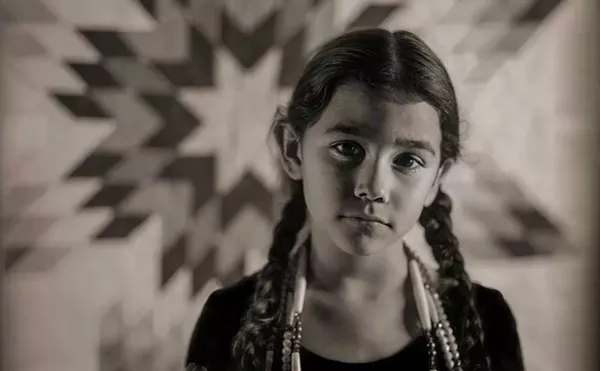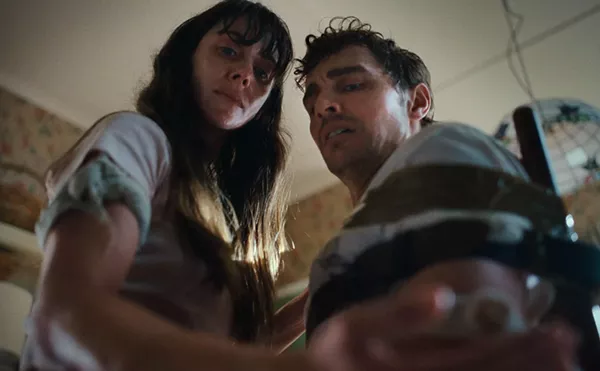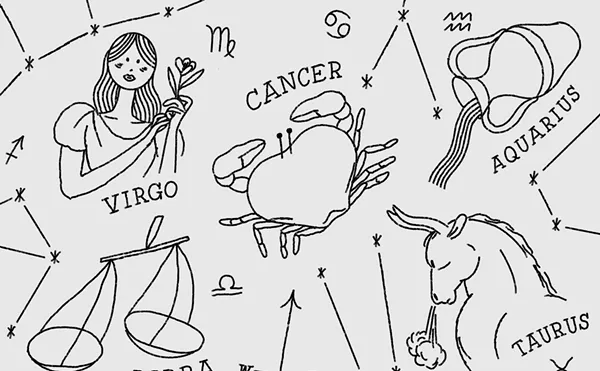
Audio By Carbonatix
[
{
"name": "GPT - Leaderboard - Inline - Content",
"component": "35519556",
"insertPoint": "5th",
"startingPoint": "3",
"requiredCountToDisplay": "3",
"maxInsertions": 100,
"adList": [
{
"adPreset": "LeaderboardInline"
}
]
}
]
Some may say that too many cooks spoil the pot. But when each cook has a specialty, the broth can be a fantastic balance between distinct flavors and the overall taste. What about blending such distinct media as modern dance, a sculpture installation, footage from the Hubble Space Telescope and a computerized video projection? "The Seven Enigmas," Dance Gallery/Peter Sparling & Co.'s premier piece for the Ann Arbor Summer Festival, does just that.
Peter Sparling, professor at the University of Michigan Department of Dance and namesake of the company, began designing seven solos years ago on the working theme of humans' relationship to the universe.
Composer Daniel Roumain then created ethereal and explosive sounds to match each dance. The solos remained as such, performed in backyards and art galleries to raise money for the company, but were never grouped together in one show.
When Sparling was ready to create one dance performance, he knew he needed more than a stage and good lighting. The "Enigmas" project wasn't simply a story to be told through dance movement.
Sparling stopped by to see visual artist and U-M art professor Jim Cogswell two years ago and invited him to design a set for his show; Sparling even performed one of the solos right in the studio with one of Cogswell's new installation pieces. Cogswell agreed immediately, but was also overwhelmed. He knew that a piece about space couldn't simply offer a starry backdrop and a space suit. It had to be big.
"I went home and told my wife what I had agreed to do for Peter, and she said, 'You don't know what you're doing.' I said, 'Peter thinks I do.' "
Cogswell extracted inspiration and vision from the dancers' movements. He wanted to react to the dance visually first and represent the movement, not any specific meaning. So drawings were made, ideas discussed. And when the two collaborators looked more closely at the drawings, their visions began to grow. Suddenly they were talking about the inside of a brain -- and the idea of an enigma in relationship to the ordinary. "We became very excited," says Cogswell, because the dances were "a revelation not of a story, but of a process of learning."
Cogswell began to think in terms of simple, everyday objects, and these have worked their way into the set design on a colossal scale. For example, a huge piece of cloth, looking like a waterfall, drapes from the ceiling to the floor, following the fluid movement of dancer Gayle Bailey, running from one side of the stage to the other. Later the cloth is pulled taut and lowered almost to the ground for William Crowley's solo. His movements are tight and strict, with flexed feet and hands.
Says Sparling, "I am finding the edge between literal, gestural movement that signals some kind of meaning and movement that is sculptural, that is sequenced such that there is no narrative. I am letting the movement speak for itself."
Lisa Johnson dances in front of a giant, motorized venetian blind whose slats flip to reveal a Cogswell painting of geometric forms. In another piece, dancers hang and reshape a rope grid while Lisa Catrett-Belrose lifts, twists and turns like a marionette.
(Julianne O'Brien-Petersen, Renee Grammatico and Jason Marchant are among the other dancers.)
The synergy of art, math and science did not end with Cogswell's drawings. Sparling and Cogswell presented their expanding work to Fred Brookstein, a research scientist at U-M whom Cogswell had met years ago. Brookstein was thrilled to work with the artists; he supplied images of brain cross sections that are projected onto the back wall during the show, and he applied to the project a computer program that he developed to study abnormal brain shapes: A computer-generated graphic grid was placed over a video image of Sparling dancing; points on the grid were then matched with specific points on Sparling's image, which was then removed, leaving a "dancing grid" which can mimic different dancers' movements.
Next, Sparling and Cogswell visited John Clarke, a research scientist in the Space Physics Research Lab at the university. Clarke offered images from outer space that he has collected for his research on Jupiter's atmosphere.
Many other people were brought on board to handle the technical complexity of the "Enigmas" project. Bob Anderson, a film, video and computer artist, worked to coordinate the visuals with the dancers, pulling all of the separate parts together to make a cohesive whole.
More than a dozen more people aided in bringing the project together.
The result is a synergistic art experience that transcends the assumption that modern dance is hard, heavy and too complicated to understand.
Approaching modern dance, Sparling says, "People think there's some kind of encoded message only accessible to an educated elite." Sparling is tired of that perception.
But he has no need to worry. After seeing "The Seven Enigmas," viewers soon will expect more of modern dance; they'll expect it to expand beyond its self-fulfilling focus and embrace, and even include, its audience.
E-mail comments to letters@metrotimes.com




